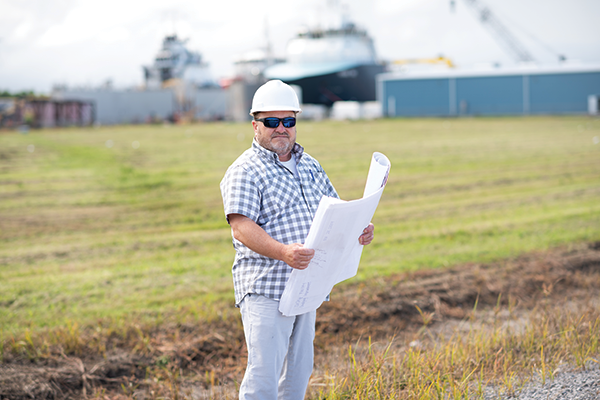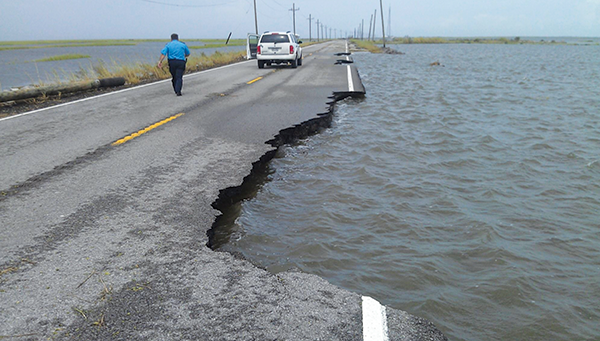
Port Terrebonne Building for the Future
September 12, 2018
Moving the Nation’s Oil
September 12, 2018WORK ONGOING TO TRY AND PROTECT LA. 1 FROM FLOODING, EROSION
In this issue of Bayou Business Monthly, there’s a full-length story on Port Fourchon and its importance to the local business community.
But there’s another facet to the story that’s even more intriguing, but is often not thought about.
There’s only one way to and from Fourchon by automobile. It’s an old state highway — La. Highway 1.
That wouldn’t otherwise be a problem except that the highway is under constant attack by Mother Nature. It’s below sea level in some spots, is outside of hurricane protection levees in others and is often highly susceptible to flooding, which, of course, is problematic in Southeast Louisiana — especially during hurricane season.
Fourchon’s day-to-day operations are dependent on La. Highway 1’s protection — an ongoing fight that’s been going on for the past several decades and which will surely continue on for decades into the future.
Progress has been made, namely with the Leeville Toll Bridge Overpass, which connects Leeville to the port — a multi-million dollar project which was completed in phases over the past several years.
But Henri Boulet, the Executive Director of the LA 1 Coalition said more work needs to be done to remove the passageway fully from harm’s way.
The LA 1 Coalition is a group which seeks to coordinate, provide and disseminate public information in relation to improving the highway system between Grand Isle and U.S. Highway 90. Boulet is the group’s executive director, but the Coalition also has a Board of Directors comprised of industry leaders in the oil and gas realm.
“We still have very far to go to physically secure La. Highway 1 to our coast,” Boulet said. But The Coalition continues to work with LA DOTD, the Governor’s Office and our Congressional Delegation to further a funding plan for La. 1 improvements.”
Coastal erosion is a big reason the highway is under nature’s attack.
Go back 100 years in history and Louisiana had marshy wetlands or solid ground all throughout Leeville, Fourchon and Grand Isle.
Today, that barrier has been mostly washed away. Leeville has been chewed up by erosion. When passing on the Toll Bridge Overpass, there is nothing but water on both sides of the road.
In the late 1800s and early 1900s, Leeville was known as Orange City and it was a fertile land for farming with fields of vegetables providing business to the small Cajun town’s economy.
“It was green. Everything was ripe,” said Howard Billiot, an elderly Galliano native. “They had everything there. Today, it’s all gone.”
Land and marsh are natural barriers for storm surges and flood
waters. Without it, the only thing that stands in the path of rising water is La. 1 and it’s often no match — flooding even in the smallest tropical disturbances.
During storm events, a flooded highway is a huge issue for industry. Work in the Gulf of Mexico slows to a halt when a storm is approaching, but companies need the highway to evacuate workers or equipment that may be on the worksite.
In the aftermath of the storm, industry needs to start again and a clear, unobstructed highway is needed to start the cycle again.
“At the end of the day, La. 1 and Port Fourchon are servicing the entire Deepwater Gulf of Mexico’s domestics energy production,” Boulet said. “This equates to 16 percent of our country domestic oil production and 4 percent of its natural gas production.”
Boulet said it’s also worth noting that the highway is important for the fishing and seafood industry, which is heavily stationed in Grand Isle, Fourchon and Leeville.
Also, if we’re ever to rebuild pieces of our coast, workers will need to have access to move machinery and personnel, which also uses the highway.
“Future La. 1 will provide an efficient, secure route to the coast to facilitate large scale coastal restoration projects in the hundreds of millions of dollars,” Boulet said. “An example of this role was recent with La. 1 being used to haul down the bulldozers and equipment to achieve the $200 million restoration of the Caminade Headland Project. Without a road to efficiently get that equipment in, cost to restoration projects along the coast of Jefferson and Lafourche parishes goes up substantially.”
Work to secure funding for La. 1 are never-ending, but progresses are being made.
The toll bridge was a huge win, securing a big chunk of the highway from Leeville to Fourchon, while serving also as an evacuation route for folks in Grand Isle.
Plans for the future are to extend the road further into Golden Meadow.
Pie in the sky hopes are to take it to Golden Meadow, which would cover all of the areas outside of Lafourche’s Ring Levee System.
“We are striving to put together a funding plan of $340 million to construct 8.3 miles of elevated highway between Golden Meadow and Leeville,” Boulet said. “Achieving this provides our community and hundreds of workers the ability to get to Port Fourchon fairly immediately following hurricanes that impact our region. With that ability, the port can perform the vital work it does post-storms in reactivating domestic energy production in the U.S. Gulf of Mexico.”
But to get money through government today isn’t easy.
Louisiana’s financial struggles have been well-documented and there isn’t much money to go around.
Boulet said The Coalition helped to secure funds for a piece of elevated highway in Leeville, which is considered a sizable win, given the times.
He’s also hopeful that the current economic upswing will help. Boulet said traffic counts at the La. 1 toll booth in Leeville recently have shown growth — a fairly accurate indicator that business has been steady, which shows that the Gulf is an entity worth investing in for the future.
“The uptick does help,” Boulet said. “It demonstrates to both the state and federal government that investment in the Gulf of Mexico is growing, as are the jobs needed to support that uptick and it makes sense to invest in infrastructure that supports a growing job market.”•










